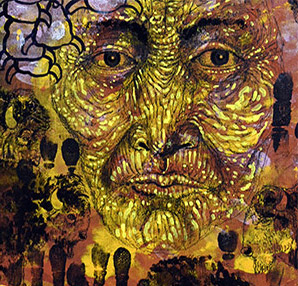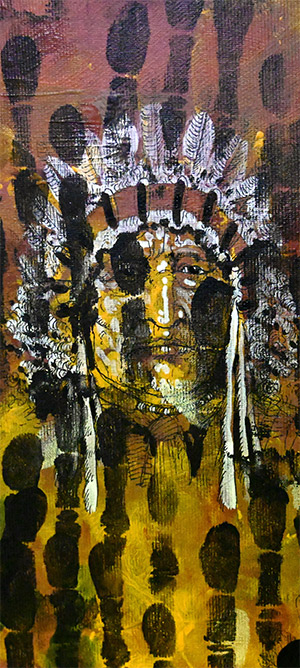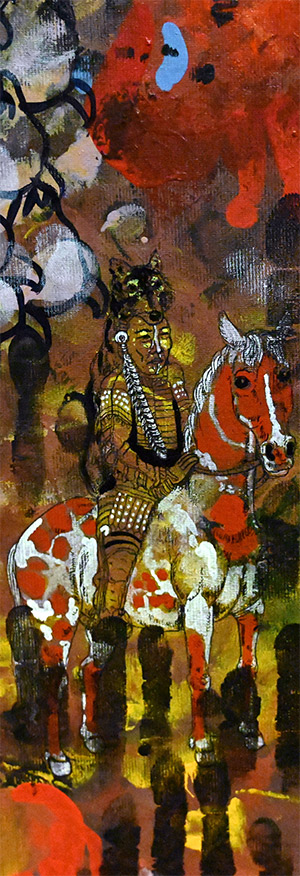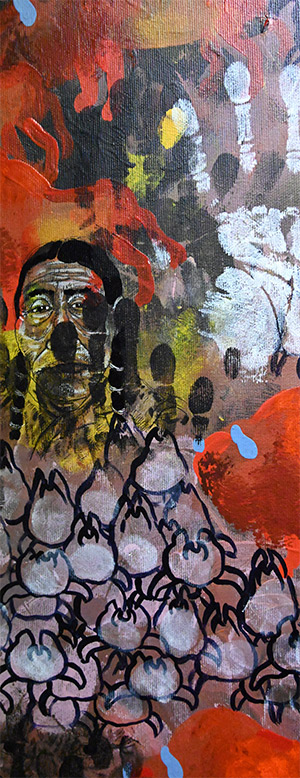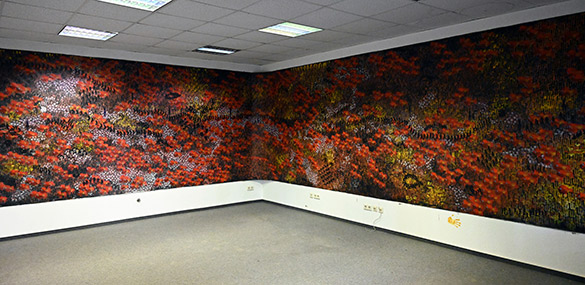
Slavery Narratives: The Atlantic slave
trade & The Native Americans by OtGO 2013–2023, acryl on canvas 215 x 1000 cm
„… This is a powerful installation that aims to build a narrative of inclusion and homage to the repressed in the past and projecting into the turmoil present. A panoramic view of the installation shows a throng of paintings dominated in a sombre, dark red color, and filled with numerous tiny images, which include naked human bodies, the artist’s hand prints, countless bisons, mountains of buffalo skulls, and portraits of Native Americans, all of which were inspired by real events taken place in the 19th century. OtGO’s own perspectives on history are here assembled in this longitudinal work: here the slaves brought from Africa are gathered with bison-hunting American Indians, where these very animals (bisons) were extirpated by the new Western settlers to control the indigenous population, thereby the freedom of all these disparate communities was cut short and exploited. The entire composition wraps up the whole room in these sombre paintings, where the viewer finds themselves engulfed in the tragic spirit of the past era which has its lasting continuity into our present. There is no easy escape from this room: the spectator is intentionally surrounded by the work, as it is installed on all four walls to dramatically enhance the feeling of being absorbed and overwhelmed by it.* “
*Caro Verbeek discusses a similar sensation of a viewer’s engulfed experience within an installation of Henri Matisse’s paper-cut panels placed on two walls of the room. See Verbeek, “Matisse's Installation of "La perruche et la sirène" as an Environment: An "Immersive" Experience”, Master Drawings, Summer 2012, Vol. 50, No. 2, “Modern & Contemporary Drawings” (Summer 2012), pp. 187-192.
More works on this topic:
Triptych: The GALLEYS of SOULS by OtGO 2013–2021 acryl on canvas 215 x 1000 cm
YouTube link: https://youtu.be/60KpRmBaYJQ?feature=shared
OtGO Studio 2022 (Work in Progress video)
Боолчлолын түүх: Атлантын далай дамнасан боолын худалдаа ба уугуул америкчууд
Одоогоос арав гаруй мянган жилийн өмнө дэлхийн мөсөн цагийн сүүл үед төв Азийн нутгаас хойд Америкт ирж суурьшсан иргэд буюу бидний хэлж заншсанаар Индианчуудын царай зүс, биe, сүсэг бишрэл, соёл, зан заншил, байгаль дэлхийтэй зохицон амьдардаг амьдралын хэв маяг нь уг гарал үүсэл нэгтэй тул Монголчуудтай тун төстэй.
15-р зууны сүүл үед Европчууд Америк тивд ирэхээс өмнө зуу гаруй өөр хэл соёлтой 50-60 орчим сая уугуул оршин суугчид мянга гаруй овог аймгуудад харьяалагдан амьдарч байжээ. Энэ цагаас хойш уугуул иргэдийн соёл мөхөж олон зуун жилийн түрэмгийлэлд өртөн дайн тулаан, хүчирхийллийн золиос болсоор 19-р зуунд ердөө нэг хоёрхон мянга орчим болтлоо цөөрсөн эмгэнэлт түүхтэй.
Түүнчлэн барууныхан анх ирэх тэр цагт хойд Америкийн тал нутагт 60 орчим сая гаруй 'бизон' зэрлэг үхэр амьдарч байсан судалгаа байдаг.
Индианчууд хэзээ ч шаардлагатай хэмжээнээс илүү ан агнадаггүй байсан ба хоол тэжээл болон ахуй амьдралын чухал хэрэглээгээ ангийн арьс ширээр хийдэг байсан юм.
Европууд нутгийн ардыг зовоож уур хилэнгий нь хүргэх, хоол хүнс аж амьдралыг нь сүйрүүлэн эрхшээлдээ оруулахын тулд бизоныг цэргийн стратегийн зорилгоор сүргээр нь хоморголон устгаж байжээ. Хожим нь төмөр зам барих үед энэ аймшигт явдал тусгай зохион байгуулалттайгаар эрчимжиж галт тэрэгнээс том сүрэг рүү үй олноор нь буудан хороож энэ амьтдыг ганц хоёрхон мянган толгой болтол нь хядаж Индианчуудын адил бараг л устган үгүй хийсэн байна.
Өнөөдөр энэ амьтан Амeрикийн бэлэг тэмдэг болж тусгай хамгаалалттай газар байснаар 350.000 болтлоо үржжээ.
Уугуул иргэдийг өөрсдийнх нь нутагт боолчлон зарцлахыг оролдсон ч тэд үймээн самуун эсэргүүцэл гаргахаас гадна газар тариалангийн ажилд сайнгүй, eвропчуудын тээж ирсэн халдварт өвчинд нэрвэгдэх нь элбэг байснаас Африк тивээс боол авчирахад хүргэжээ. Тэд биe чангатай, ажиллахад хүчтэйгээс гадна газар мэдэхгүй тул зугтах боломжгүй байв.
Атлантын далай дамнасан боолын худалдаа
15-р зууны сүүл үед Eвропуудад аль хэдийн эзлэгдсэн Африкийн баруун эрэг нь боолуудыг шилжүүлэн ачих хамгийн чухал цэг болжээ. Энэхүү боолын Амeрик руу шилжүүлэх худалдаа 400 орчим жил үргэлжилсэн. Ялангуяа 17-р зууны үeд Амeрик тивд чихрийн нишингэ, хөвөн, тамхины тариалалтад хямд ажиллах хүчний эрэлт хэрэгцээ ихсчээ.
Энэ гамшигт түүх мартагдах, эсвэл зориудаар мартагдуулах байдал ажиглагддаг. Өчигдөргүй өнөөдөр гэж үгүй түүхээс сургамж авч, хүлцэл өчих мэт олон сая гэм зэмгүй үрэгдсэн хүмүүсийн гэгээн дурсгалд зориулж энэхүү 10 метр урт панорама зургийг 10 орчим жил үргэлжлүүлэн бүтээсэн болно. Хоморголон устгалтыг тэсэн амьд үлдсэн цөөхөн хэдэн Амeрикийн уугуул иргэдийг түүхэнд мөнхжүүлэхийн тулд тэр үеийн гэрэл зурагнаас бодит хүмүүсийн хөрөг зургийг ашиглаж бүтээсэн юм.
Олон мянган Бизоны хохимой толгойгоор босгосон хашлага хана, овоог харуулсан баримт материалыг ашиглан зургийн төв дэлгэмэл зохиомжийн дүрслэлийг хийсэн ба энэ нь дэвсгэр өнгөнөөс ялгаран гарч ирэх бизон сүрэгтэй уусан холбогдоно.
Африк боолын амьдралыг хүүрнэх байдлаар харуулсан. (Газар тариалан дээр ажиллах, ажилдаа явах, харих цуваа, шийтгүүлэх, оршуулга г.м..)
Бохир, маш их зовлон дагуулсан түүхийн талаар байсан тул хамгийн сүүлд гараа хар будганд дүрж зөвхөн хурууны хэвийг сая сая золиослогдсон хүмүүний шаналал зовлонтой сүнсийг аргадах мэт мөр гаргаж үлдээсэн.
Зураач ОТГО. 2024 оны 6 сарын 7нд, Базель хот Швейцар улс.
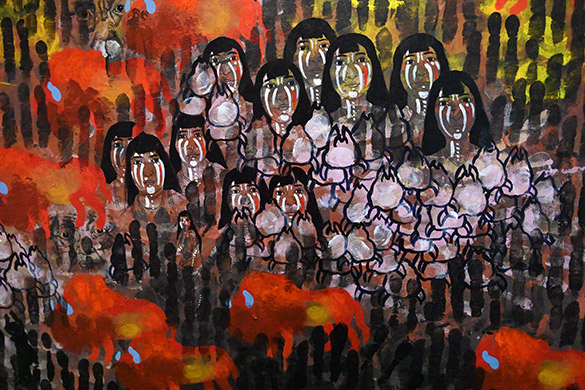
Detailed view: Slavery Narratives: The Atlantic slave trade & The Native Americans
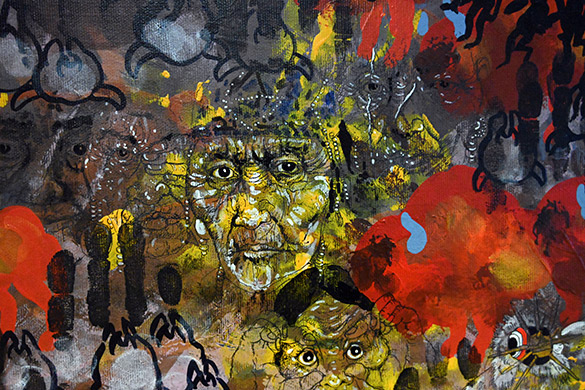
Detailed view: Slavery Narratives: The Atlantic slave trade & The Native Americans
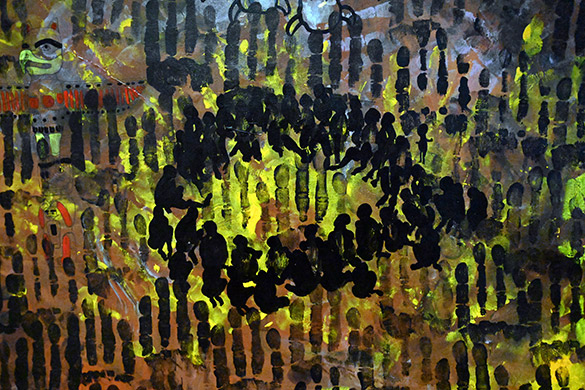
Detailed view: Slavery Narratives: The Atlantic slave trade & The Native Americans
The history of Native Americans and the transatlantic slave trade
More than ten thousand years ago, at the end of the global ice age, the people who settled in North America from Central Asia, or as we say, the Indians, had the same origin as the Mongols. Ethnic characteristics, such as face, body, beliefs, culture, customs and lifestyle in harmony with nature are similar between Native Americans and Mongols.
Before the Europeans arrived in America at the end of the 15th century, there lived about 50–60 million indigenous people with more than a hundred different languages and cultures in more than a thousand different tribes. Since then, the culture of the indigenous population has been destroyed by centuries of aggression and it is a tragic story that in the 19th century, due to wars and violence, they were decimated to only about one to two thousand people.
In addition, there is a study that says that at the time of the first arrival of the Europeans, more than 60 million wild "bison" cattle lived on the plains of North America.
The Indians never hunted more bison than they needed to survive. Not only used they their food, but as well the important utensils of the natives' lives were also made from their leather.
The Europeans exterminated the bison as a military strategy to inflict suffering and anger on the natives, as well as to deprive them of food and livelihood. Later, when the railroad was built, this terror was intensified by special precautions and large herds were shot ‘en masse‘ from trains, which is why these animals were exterminated to one or two thousand, almost like the natives.
Today, the bison has become a symbol of America and has multiplied to about 350,000 specimens in protected areas. Attempts to enslave the natives in their own country and make them work in agriculture failed. They were not suited to this work and rebelled. They also often suffered from infectious diseases brought in by the Europeans. This led to slaves being imported from Africa. These were usually physically stronger and were forced to work outside for long periods of time. They also had no opportunity to escape.
The transatlantic slave trade
At the end of the 15th century, the west coast of Africa, which was already occupied by Europeans, became the most important trading point for slaves. This slave trade to America lasted for about 400 years. In the 17th century in particular, the demand for cheap labor in the cultivation of sugar cane, cotton and tobacco increased in America. This tragic story is often and deliberately forgotten.
I have dealt with this for a long time and intensively, so that since 2013 I have created a 10meter long panoramic painting - The Atlantic slave trade & The Native Americans - for about 10 years, in memory of millions of innocent people and to free their souls from suffering. Historical photographs of this time were used as important documents for the drawings as a template to immortalize the few Native Americans who survived the genocide.
I used documentary footage of fences and mounds built from the heads of thousands of bison to illustrate the central theme of the painting, which contrasts with the herds of bison that stand out against the background.
The Indians and the life of the African slaves were portrayed in a narrative way (work on the land, going to work, procession home, punishment, funeral, etc.). Since it is a dirty and painful story, the last thing I did was dip my right hand in black paint and leave only the fingerprints on the canvas, as if I wanted to comfort the souls of the tormented millions of victims.
OTGO June 7, 2024 Basel, Switzerland
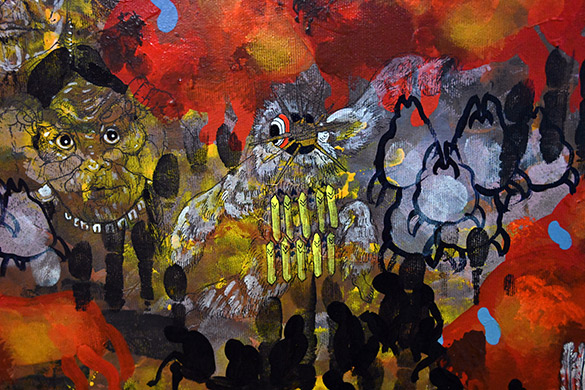
Detailed view: Slavery Narratives: The Atlantic slave trade & The Native Americans
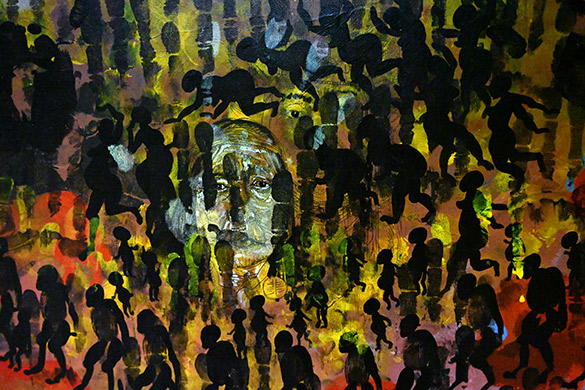
Detailed view: Slavery Narratives: The Atlantic slave trade & The Native Americans
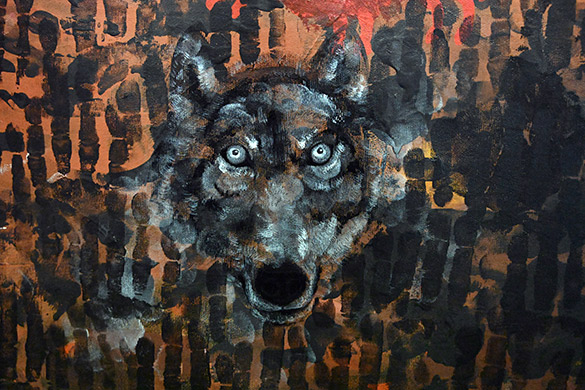
Detailed view: Slavery Narratives: The Atlantic slave trade & The Native Americans
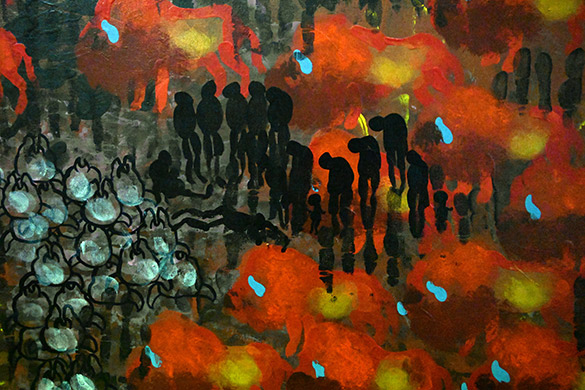
Detailed view: Slavery Narratives: The Atlantic slave trade & The Native Americans
„… Dies ist eine kraftvolle Installation, die darauf abzielt, eine Erzählung des Themas und eine Hommage an das in der Vergangenheit Unterdrückte zu schaffen und in die turbulente Gegenwart zu projizieren. Ein Panoramablick auf die Installation zeigt eine Ansammlung von Gemälden, die in einer düsteren, dunkelroten Farbe dominieren und mit zahlreichen winzigen Bildmotiven gefüllt sind, darunter nackte menschliche Körper, Handabdrücke des Künstlers, unzählige Bisons, Berge von Büffelschädeln und Porträts von Native Americans, die alle durch reale Ereignissen aus dem 19. Jahrhundert inspiriert wurden. OtGOs eigene Perspektive auf die Geschichte wird in einem großen Längsformat zusammengefasst: Die aus Afrika mitgebrachten Sklaven werden vom Künstler bei amerikanischen Indianern, die Bisons jagen, versammelt, und zwar genau an dem Ort, wo die Bisons von den neuen westlichen Siedlern ausgerottet wurden, um die indigene Bevölkerung zu kontrollieren. So die Siedler die Freiheit all dieser unterschiedlichen Gemeinschaften in ihrem Lebensraum beschneiden und sie ausnutzen. Die gesamte Komposition erfüllt fast den gesamten Raum mit diesen düsteren Gemälden, mit denen der Betrachter in gewisser Weise in den tragischen Geist der vergangenen Ära eintaucht, deren Nachwirkungen sich bis in unsere Gegenwart entfalten. Es gibt kein einfaches Entkommen aus diesem Raum: Der Betrachter ist gezielt von der Arbeit, die an allen vier Wänden des Raumes installiert ist, umgeben, um das Gefühl, von ihr absorbiert und überwältigt zu werden, dramatisch zu verstärken.* “
*Caro Verbeek diskutiert ein ähnliches Gefühl der verschlungenen Erfahrung eines Betrachters im Rahmen einer Installation von Henri Matisses aus Papier geschnittenen Tafeln, die an zwei Wänden des Raums angebracht sind. Siehe Verbeek, „Matisse's Installation of „La perruche et la sirène“ as an Environment: An „Immersive“ Experience“, Master Drawings, Sommer 2012, Bd. 50, Nr. 2, „Modern & Contemporary Drawings“ (Sommer 2012), S. 187–192.
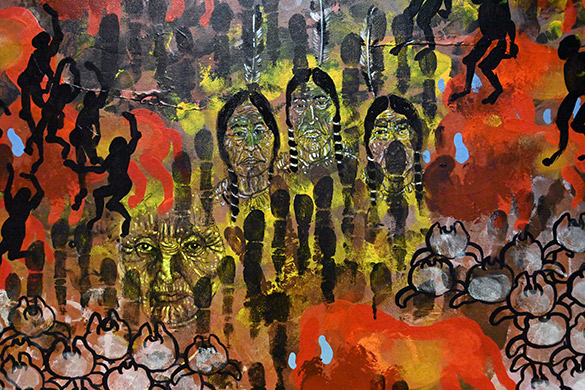
Detailed view: Slavery Narratives: The Atlantic slave trade & The Native Americans
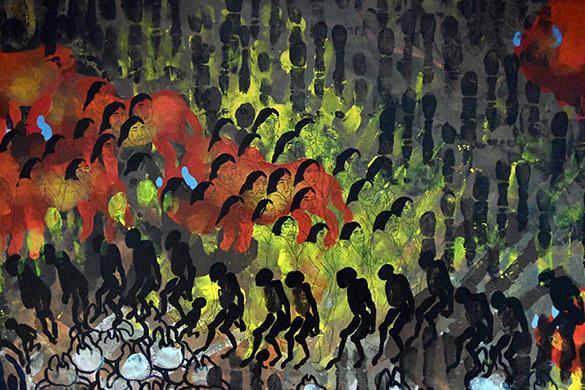
Detailed view: Slavery Narratives: The Atlantic slave trade & The Native Americans
Die Geschichte der amerikanischen Ureinwohner und des transatlantischen Sklavenhandels
Vor mehr als zehntausend Jahren, am Ende der globalen Eiszeit, hatten die Menschen, die sich aus Zentralasien in Nordamerika niederließen, oder wie wir sagen, die Indianer, den gleichen Ursprung wie die Mongolen. Ethnische Merkmale, wie Gesicht, Körper, Glauben, Kultur, Bräuche und der Lebensstil im Einklang mit der Natur ähneln sich zwischen den amerikanischen Ureinwohnern und den Mongolen.
Bevor die Europäer Ende des 15. Jahrhunderts in Amerika ankamen, lebten dort etwa 50–60 Millionen Ureinwohner mit mehr als hundert verschiedenen Sprachen und Kulturen in mehr als tausend verschiedenen Stämmen. Seitdem wurde die Kultur der indigenen Bevölkerung durch jahrhundertelange Aggression zerstört und es ist eine tragische Geschichte, dass sie im 19. Jahrhundert aufgrund von Kriegen und Gewalt auf nur noch etwa ein- bis zweitausend Menschen dezimiert wurden.
Darüber hinaus gibt es eine Studie die besagt, dass zum Zeitpunkt der ersten Ankunft der Europäer mehr als 60 Millionen „Bison“-Wildrinder in den Ebenen Nordamerikas lebten. Die Indianer jagten nie mehr Bisons als sie zum Leben brauchten. Es waren nicht nur ihre Nahrung, auch die wichtigen Gebrauchsgegenstände des Lebens der Ureinwohner wurden aus ihrem Leder angefertigt.
Die Europäer rotteten die Bisons als militärische Strategie aus, um den Ureinwohnern Leid zuzufügen und sie zu verärgern, sowie um ihnen die Nahrung und Lebensgrundlage zu nehmen. Später, als die Eisenbahn gebaut wurde, wurde dieser Schrecken durch besondere Vorkehrungen noch verstärkt und große Herden wurden massenhaft aus den Zügen geschossen, weshalb diese Tiere bis auf ein- oder zweitausend Stück ausgerottet wurden, fast so wie die Ureinwohner.
Heute ist der Bison zu einem Symbol Amerikas geworden und hat sich in Schutzgebieten auf ca. 350.000 Exemplare vervielfacht.
Versuche, die Eingeborenen in ihrem eigenen Land zu versklaven und sie in der Landwirtschaft arbeiten zu lassen, scheiterten. Sie eigneten sich nicht für diese Arbeit und rebellierten. Auch litten sie oft an Infektionskrankheiten, die von den Europäern eingeschleppt wurden. Das führte dazu, dass man Sklaven aus Afrika einführte. Diese waren meist körperlich stärker und wurden gezwungen, lange Zeit draußen zu arbeiten. Sie hatten auch keine Möglichkeit zu fliehen.
Der transatlantische Sklavenhandel
Ende des 15. Jahrhunderts wurde die Westküste Afrikas, die bereits von Europäern besetzt war, zum wichtigsten Umschlagplatz für Sklaven. Dieser Sklavenhandel nach Amerika dauerte etwa 400 Jahre. Vor allem im 17. Jahrhundert stieg in Amerika die Nachfrage nach billigen Arbeitskräften beim Anbau von Zuckerrohr, Baumwolle und Tabak.
Diese tragische Geschichte wird oft und absichtlich vergessen!
Ich habe mich lange und intensiv mit dieser auseinander gesetzt, sodass ich seit 2013 etwa 10 Jahre lang ein 10 Meter langes Panorama-Gemälde - The Atlantic slave trade & The Native Americans - geschaffen habe, zum Gedenken an Millionen von unschuldigen Menschen und um deren Seelen von Leid zu befreien. Historische Fotografien dieser Zeit wurden als wichtige Dokumente für die Zeichnungen als Vorlage verwendet, um die wenigen amerikanischen Ureinwohner, die den Völkermord überlebten, zu verewigen.
Dokumentarische Aufnahmen von Zäunen und Hügeln, die aus den Köpfen Tausender Bisons errichtet wurden, verwendete ich, um das zentrale Thema des Gemäldes zu veranschaulichen, das im Kontrast zu den Bisonherden steht, die sich vom Hintergrund abheben.
Die Indianer und das Leben der afrikanischen Sklaven wurde auf erzählerische Art und Weise dargestellt (Arbeit auf dem Land, zur Arbeit gehen, Prozession nach Hause, Bestrafung, Beerdigung usw.).
Da es um eine schmutzige und schmerzhafte Geschichte geht, tauchte ich als letztes meine rechte Hand in schwarze Farbe und hinterließ auf der Leinwand nur die Fingerabdrücke, als ob ich die Seelen der gequälten Millionen Opfer trösten wollte.
OtGO 7. Juni 2024 Basel, Schweiz
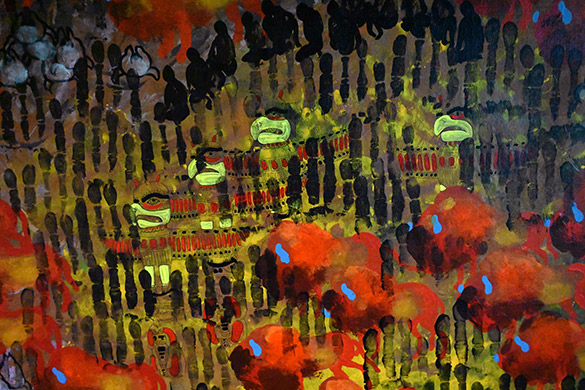
Detailed view: Slavery Narratives: The Atlantic slave trade & The Native Americans
